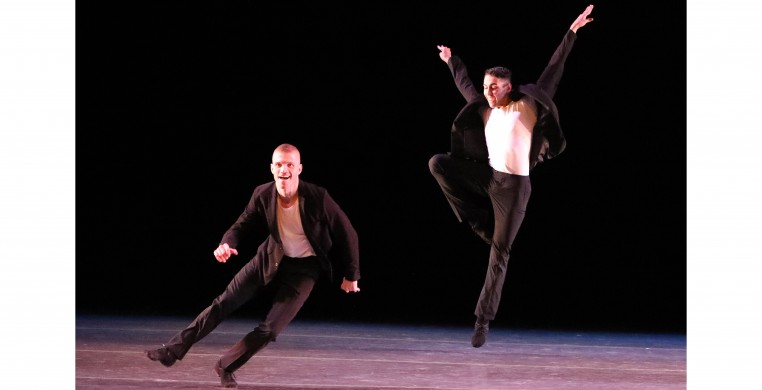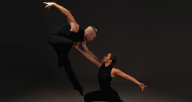The North Shore Center for the Performing Arts in Skokie has been, for some time, an alluring oasis for Chicago dance companies adrift in the hustle and bustle of the city—spacious lobby, great backstage facilities, an opulent auditorium (and easy parking!). Chicagoans don’t mind the short trip, either, especially when there is as high a quality of performance as was presented by Giordano Dance Chicago (GDC) last Saturday evening.
“Illuminate,” the Winter program presented by GDC, states, in a written preface to the performance, that it is a celebration of “Beauty, Community, Energy, Love and Gratitude,” and features a recently expanded company of dancers, minus alum Zach Heller, who retired from the company after last Fall’s performance at the Harris Theatre. “Illuminate” is a recapitulation of GDC’s 2021, year-ending concert at the Harris, but with a couple of new additions plucked from their extensive repertoire.
The show begins with “Opening”, a collaborative effort created in 2021 with choreography created communally by the company. They are joined on stage by vocal artist Bongi Duma, whose vocal riffing in the South African choral-style hits all the right notes. I felt as if I was attending a religious revival meeting and couldn’t help but getting swept up in the sentiment. “It’s a new day,” sang Duma, as the entire on-stage congregation leapt, reached, floated on white cotton wings. The display is grand, and the euphoria that it creates is permeable.
“Alegría,” originally choreographed in 2011 by Keisha Lalamar, sneaks in almost the full company, complete with costume change, right under our noses via a seamless and smooth transition, changing the clothes and atmosphere from light and bright to dark and ominous. Before our eyes, rival factions form and charge at each other, their low, tight, angular formations congealing, then splintering into smaller groups, all while dancing on the razor’s edge of a 3-3-3-2 meter. The music, by the always-pleasing flamenco guitar duo of Rodrigo y Gabriela, was especially rhythmically challenging. I am in awe of the sharpness of Lalamar’s attention to the music’s off-balance syncopation and the acuity of the dancers’ movements.
“A Little Moonlight,” choreographed in 2010 by Autumn Eckman, is a duet performed by Adam Houston and Katie Rafferty, created in the style of a 1940s Hollywood couple’s dance interlude—think Gene Kelly and Debbie Reynolds at the end of “Singin’ in the Rain,” only much more technical. The familiar premise of a couple finally expressing their love for each other keeps the pair moving from side to side, Rafferty gliding on a breeze, while Houston, looking as if he’s getting his second wind after a night out on the town, eagerly bounds after her. The requisite and anachronistic “musical comedy” brand of humor is present—the pair giggle while wiggling their butts at each other, or roll back their eyeballs dramatically, or play small games of peekaboo (“Where’d you go…There you are!) But anyone who has seen enough Fred Astaire movies—where someone inevitably must get kicked in the butt for comedic effect—knows that this is par for the course of the style.
Ray Leeper’s 2014 work “Feelin’ Good Sweet” scratches that itch that one gets when thinking about jazz dance found on 1950s Broadway and motion pictures. It even begins with a smoldering tribute to Bob Fosse, as a lone dancer slinks across the stage wearing a black bowler hat, pulling drags from a prop cigarette. The work is indicative of that 1950s style, with men in fedoras and puffed-up chests taking long, lunging gallops across the stage; the women, in purple corsets, counter and evade, clear objects of desire. Like the previous piece, “A Little Moonlight,” there is an anachronistic sense of absurd humor to be found, but it’s so absurd, often facing the audience, that unlike the previous piece, the viewer is in on it. They’re the cool kids, and if they say that “it’s cool,” then it’s cool. Hunched shoulders, rubber necks, prancing on tip toes. . . it is goofiness taken seriously, and is satisfying to watch.
Opening the second half is a work from 2018, titled “Take A Gambol” and choreographed by Joshua Blake Carter. The premise is identical to the previous work, including the period aesthetic, the women as objects of desire and identical costuming. This time the women get pants and the hat. I think the work, though performed well enough, suffered from following Leeper’s “Feelin’ Good Sweet.” Up until now, each piece in the program has been radically different, instead of more of the same. Even the quirky sense of humor suffers from overexposure—although the repeating group pantomime imitating the instructions given by Perry Como, singing “Catch a falling star and put it in your pock-et…” is a fun, memorable aside. “Take A Gambol” would have made more of an impact if it had not followed a similar work in the program.
What follows is another duet, this time adhering to the more moody, existential idiom that we call “contemporary” dance. “All For You,” choreographed in 2020 by Adam Houston and performed by Skyler Newcom and Ashley Downs, is a nice palette-cleanser that broke cleanly with the overarching theme of bright-faced and abundant joy that pervaded the evening—and I mean that in a good way! Instead, Downs is like an oceanic wave caught between two landmasses, sloshing capriciously back and forth, at one moment introspective, the next hurling into the nearby rock-faced cliffs (Newcom) and splashing over his peaks—it is all that Newcom can do to keep the wave from spilling its contents entirely, as Downs leaps and crests overhead.
The evening culminates with “Pyrokinesis,” a work choreographed in 2007 by Christopher Huggins. Now this is a finale! If this work had occurred at any other point in the program, I would have been confused, but it fits right at home as a wrap-up for the whole show. Each dancer gets a chance to display a specialty and it’s just fireworks after fireworks after. . . How the company managed to produce such a high-energy finish is astounding and I can’t tell if the standing ovation in the audience is out of love for the performers or that we were roused to our feet by the work itself—probably a little of both!
Though lacking any kind of through line that connects the various works, the variety kept the program interesting. In fact, I think that they could have branched out even more. It was only a sense of repetitiveness that slowed down the show’s momentum. When it was over, I was left still wanting more, so the next time Giordano Dance Chicago calls you out past the city limits in the winter, slap on those boots, replace the dibs in your parking spot and make the trek, because it’s worth it.


